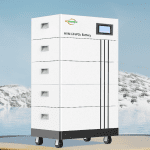High voltage lithium ion battery have become the basis of modern home energy storage, changing how we manage and utilize electricity and affecting many industries. From electric vehicles to renewable energy storage systems, high-voltage lithium-ion batteries deliver higher performance, greater efficiency, and reliability. This comprehensive guide will dive into everything you need about high-voltage lithium-ion batteries.
The composition and working principle of high voltage lithium ion battery
High voltage lithium ion batteries comprise several vital components: cathode, anode, separator, electrolyte, and current collector. The cathode is usually made from a lithium metal oxide, such as lithium cobalt oxide or lithium iron phosphate, which is used as the positive electrode. Traditionally composed of graphite or carbon-based material, the anode acts as the negative electrode. A separator made of porous material keeps the positive and negative electrodes physically separated while allowing lithium ions to pass through. A solvent dissolves lithium salts to facilitate the movement of lithium ions between the cathode and anode. Finally, current collectors made from conductive materials such as copper and aluminum collect the current generated during charging and discharging.
The working principle of high voltage lithium ion batteries revolves around the movement of lithium ions between the positive and negative electrodes during charge and discharge cycles. During charging, lithium ions move from the cathode to the anode through the electrolyte and are stored within the anode material. During discharge, the stored lithium ions move back to the cathode, releasing electrical energy that can be used to power electronic devices.


Applications of high voltage lithium ion battery in various industries
High voltage lithium ion batteries are widely used in various industries due to their high energy density, rechargeability, and versatility. They provide the energy storage needed to drive electric motors, improving efficiency, reducing emissions, and extending driving range compared to traditional internal combustion engine vehicles. High voltage lithium ion batteries are also suitable for grid-scale energy storage systems to store excess energy generated by renewable energy sources such as solar and wind. It can help stabilize the power grid, balance supply and demand, and provide backup power during power outages. In addition, high-voltage lithium-ion batteries are suitable for various industrial applications, including forklifts, warehouse equipment, and material-handling vehicles. They provide efficient and reliable power solutions for heavy-duty operations, increasing performance and reducing maintenance costs.


Advantages and Benefits of High Voltage Lithium Ion Batteries
High voltage lithium ion batteries offer many advantages over traditional energy storage technologies. High-voltage lithium-ion batteries have high energy density and can store large amounts of energy in a relatively small, lightweight package. Making them ideal for applications where space and weight are critical factors. Battery packs typically have a long cycle life and can withstand many charge-discharge cycles, which allows them to last longer and require replacement less frequently.
High voltage lithium ion batteries also charge more quickly than other battery chemistries. At the same time, they have high charge and discharge efficiency, which means they can convert stored energy into electrical energy with minimal losses. Their low self-discharge rate means they retain a charge for long periods when not in use. This makes them suitable for applications requiring long-term energy storage.

Related challenges faced
The emergence of high-voltage lithium-ion battery technology will also face some problems. First of all, safety is the most critical issue. High pressure may increase the risk of fire and explosion, especially during abnormal operations or accidents. Therefore, temperature monitoring using fireproof materials and battery management systems is necessary. Scalability is also an important issue, and as the electric vehicle market grows and renewable energy becomes more widespread, demand for high-voltage lithium-ion batteries will continue to rise. Therefore, it is also essential to ensure that battery technology can meet the growing demand and realize sustainable supply chain development and manufacturing development.
Battery management system
The battery management system (BMS) is also an essential part of the high voltage lithium ion battery and is responsible for monitoring, controlling, and protecting the battery pack. Monitoring capabilities include measuring battery voltage, current, and temperature to ensure safe operation. This data helps optimize battery performance and lifespan while preventing overcharging, over-discharging, and overheating.
Secondly, BMS can also control high-voltage lithium-ion batteries’ charging and discharging process to maintain optimal conditions and prevent damage. It regulates current flow into and out of the battery pack, ensuring efficient energy use and maximizing battery life. BMS can also facilitate communication between the battery pack and the vehicle or energy storage system, providing real-time data monitoring and diagnostic functions. Enables predictive maintenance, fault detection, and performance optimization to improve battery reliability and efficiency.
Ultimately
The emergence of high voltage lithium ion batteries has brought many conveniences to applications in our lives. From powering electric vehicles to enabling the integration of renewable energy, these batteries are driving innovation and shaping the future of multiple industries.










